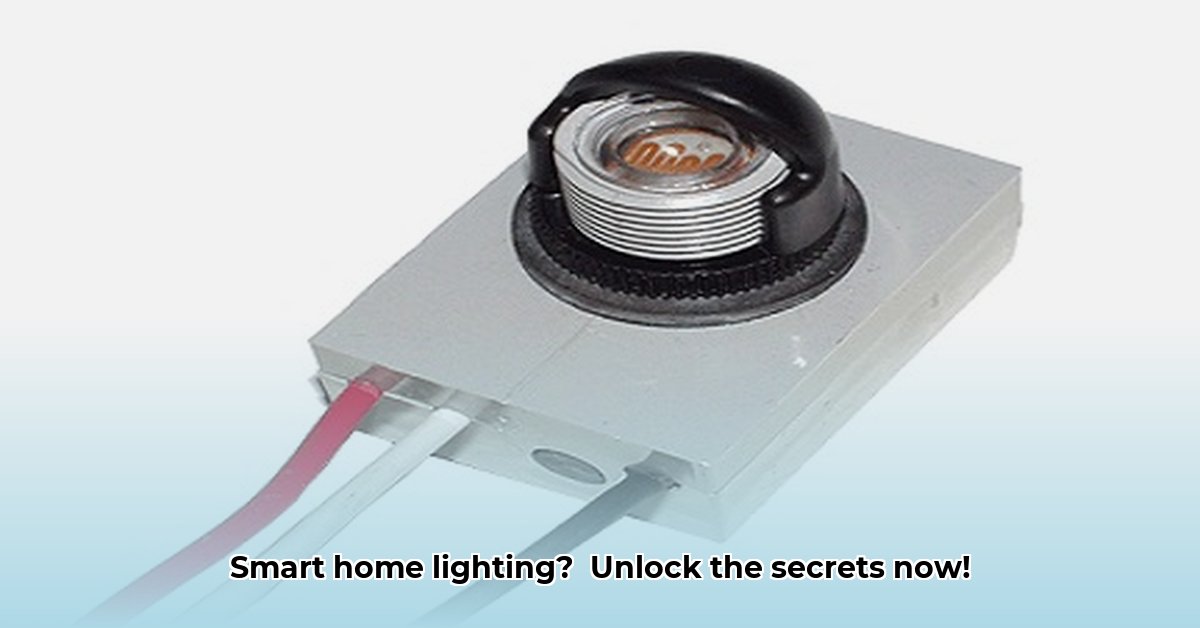
Smart home lighting enhances convenience and energy efficiency, but selecting the right photocell sensor is crucial for optimal performance. This guide simplifies the process, helping you choose a sensor that perfectly matches your needs and budget. We'll explore sensor types, key features, installation, and troubleshooting, empowering you to create a truly intelligent lighting system. For more in-depth information on photocells, check out this helpful resource: Lola's Photocell Guide.
Decoding Photocell Sensor Types
Photocell sensors come in various types, each with unique strengths and weaknesses. Understanding these differences is fundamental to making the right choice.
Photodiodes: These sensors offer the fastest response times and highest accuracy. They're ideal for applications requiring precise light level control, such as porch lights needing immediate activation at dusk. However, they often come with a higher price tag.
Phototransistors: Providing a balance between speed and cost, phototransistors strike a good middle ground. They're faster than photoresistors but not as fast as photodiodes, making them suitable for a variety of home lighting scenarios.
Photoresistors: The simplest and most affordable option, photoresistors are best for basic on/off switching. Their slower response time makes them unsuitable for applications requiring precise light level adjustments. They are generally perfect for less demanding applications such as garage lights.
The best sensor type depends on your desired level of precision and budget. For instance, do you need precise, immediate responses or is a simple on/off switch sufficient?
Key Factors for Choosing Your Photocell Sensor
Several critical factors influence your sensor selection. Carefully considering these will lead to a more satisfying and efficient outcome. Does a faster response time justify the higher cost? Is high sensitivity necessary in your environment?
Sensitivity: This dictates how dim the ambient light must be before the sensor triggers the lights. High sensitivity is ideal for low-light environments, while lower sensitivity might be preferred in brighter areas to prevent accidental activation.
Response Time: This measures how quickly the sensor reacts to changes in light levels. A fast response time creates a smoother transition between light and darkness – crucial for eliminating flickering.
Ambient Light Conditions: The installation location significantly impacts sensor performance. A sensor in direct sunlight behaves differently from one under a covered porch. Understanding your application's lighting will guide the sensitivity selection.
Power Requirements: Always verify compatibility between the sensor's voltage and your home's electrical system. Using the incorrect voltage can damage the sensor or wiring.
Mounting Options: Sensors offer various mounting methods: stem, surface, or twist-lock. Choose a method compatible with your lighting fixture for easy installation. Think about accessibility for future maintenance.
Additional Features: Some sensors include a time delay feature preventing rapid on/off cycles triggered by brief light changes (e.g., passing headlights). Consider features that enhance your specific needs.
Comparing Photocell Sensors: A Sample Table
The following table offers a simplified comparison of three common sensors. Remember that specific features and prices vary amongst brands and models; always consult the manufacturer's specifications.
| Feature | Sensor A (Premium) | Sensor B (Mid-Range) | Sensor C (Basic) |
|---|---|---|---|
| Type | Photodiode | Phototransistor | Photoresistor |
| Sensitivity | High | Medium | Low |
| Response Time | Very Fast | Fast | Slow |
| Voltage | 12V DC | 24V AC/DC | 12V DC |
| Mounting | Stem & Surface | Surface Mount | Twist Lock |
| Time Delay | Yes | No | No |
| Approximate Cost | $20 - $30 | $12 - $18 | $5 - $10 |
Installation and Troubleshooting
Installing a photocell sensor is typically straightforward, following the manufacturer’s instructions. For outdoor use, ensure the chosen sensor is weatherproof.
Troubleshooting Tips:
- Power Supply: Verify the sensor receives power.
- Wiring: Check for secure wire connections.
- Placement: Ensure proper light exposure; remove any obstructions.
- Sensor Lens: Clean the lens if dirty.
Making the Informed Choice: Your Personalized Lighting System
Choosing the right photocell sensor involves careful consideration of your specific needs and budget. Prioritize factors such as sensor type, sensitivity, response time, location, and mounting options. Thorough research will save you money and ensure a flawlessly functioning smart home lighting system. "Investing time in research now prevents future headaches," advises Dr. Anya Sharma, Electrical Engineering Professor at MIT.
Indoor vs. Outdoor Sensor Considerations: Location Matters
The location of your sensor drastically affects your choice.
Indoor: Aesthetics, ease of installation, and smart home integration are priorities. Ambient light levels are relatively consistent.
Outdoor: Weather resistance is paramount. The sensor must withstand harsh weather conditions. Consider surrounding light pollution and choose accordingly.
Key Sensor Features Explained Again: Reinforcing Decision Points
We revisit key features to crystallize your decision-making. Which factors are most important for you? Think of how you will use your sensor.
- Sensitivity: Adjusts light activation thresholds based on ambient conditions.
- Response Time: Impacts how quickly lights react to changing light levels.
- Power Consumption: Crucial for minimizing energy waste.
- Compatibility: Ensures seamless integration with your smart home ecosystem.
- Durability: Select durable sensors from reputable brands for long-term reliability.
- Mounting Options: Choose mounts suitable for your installation location, ensuring easy access.
Step-by-Step Sensor Selection Guide
- Define your needs: Identify indoor/outdoor application and lighting requirements.
- Set your budget: Photocell sensors range in cost; define your spending limit.
- Check compatibility: Verify compatibility with your smart home system (if applicable).
- Research models: Compare specifications and read reviews from reputable sources.
- Make your choice: Select the sensor that best meets your needs.
- Install correctly: Follow manufacturer instructions meticulously.
Troubleshooting Common Problems
- Non-triggering sensor: Check wiring, placement, and sensitivity settings.
- Intermittent activation: Adjust sensitivity or response time settings.
- Sensor failure: Replace the sensor with a new, reliable unit. Always select well-reviewed brands.